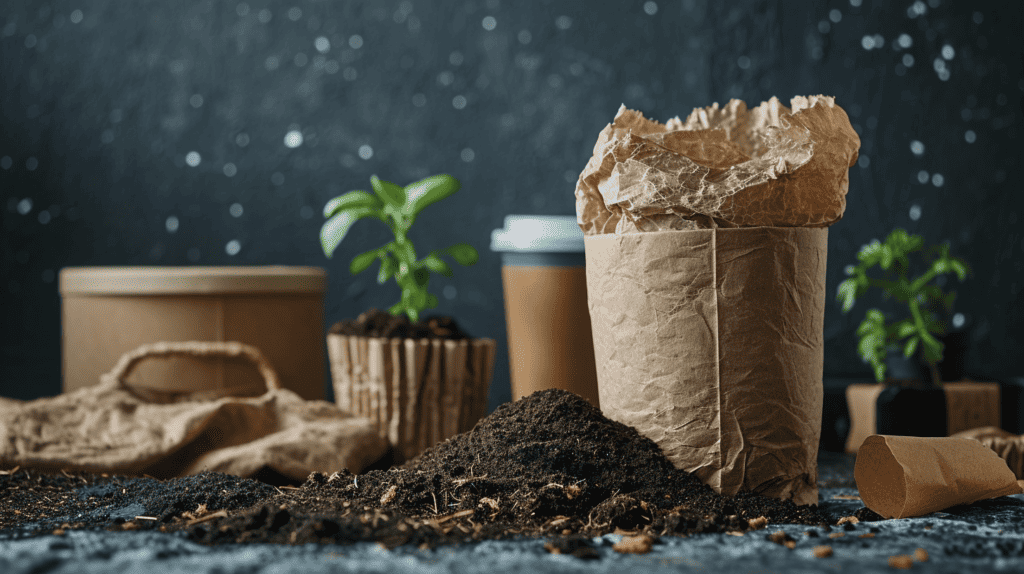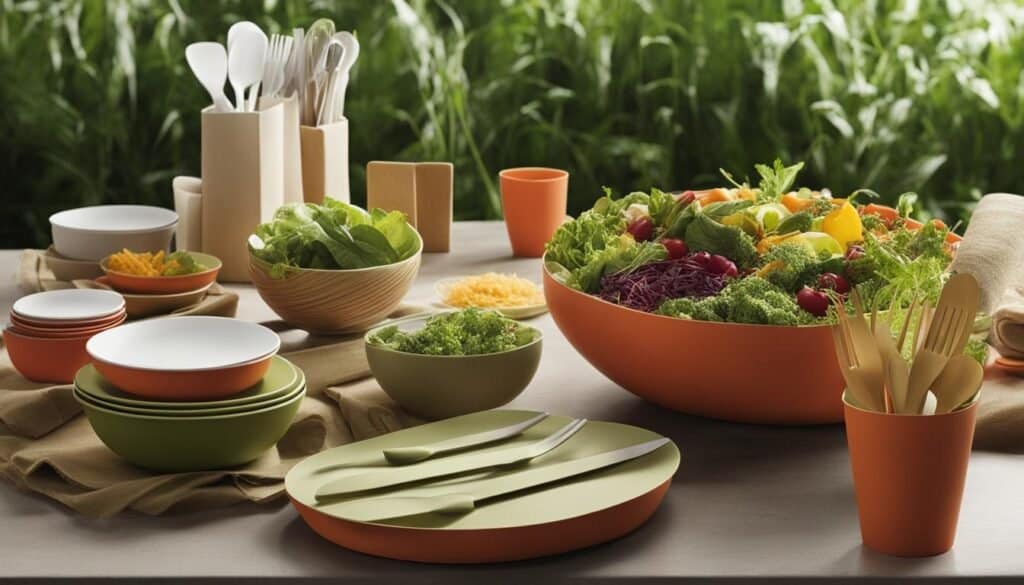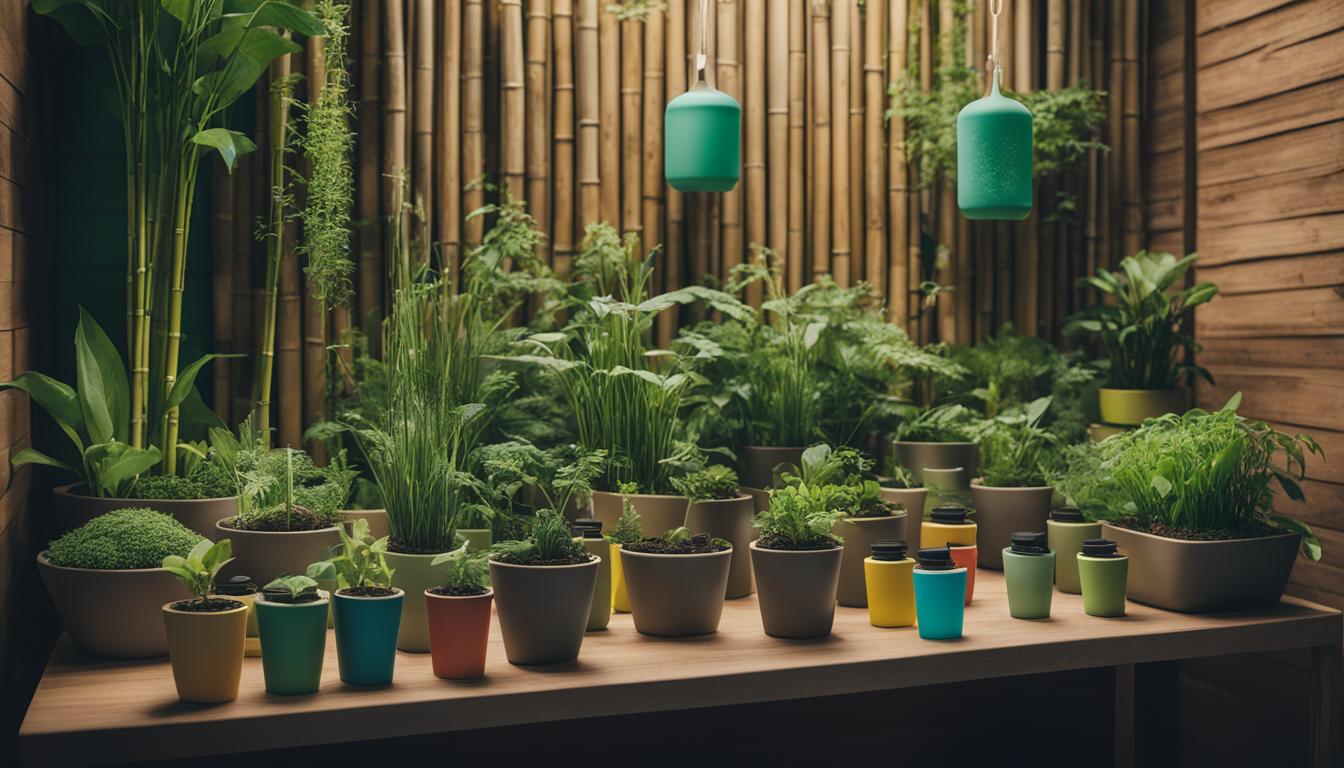As a professional copywriting journalist, I have witnessed a remarkable shift towards sustainable product design and the integration of eco-friendly, compostable materials in various industries. With the aim of promoting a circular economy and fostering environmentally friendly practices, businesses are increasingly focusing on using sustainable materials, such as biodegradable packaging, as alternatives to traditional plastics.
In this article, we will look at the game-changing innovations in compostable materials that are reshaping product design, from Paptic and Ecovative to Piñatex, and explore why sustainable packaging is not just a trend, but a necessity for the modern consumer. We will also delve into the challenges faced when using biodegradable materials and the future of environmentally responsible practices in product design.
Key Takeaways
- Compostable and biodegradable materials offer eco-friendly solutions in product design, reducing the environmental impact and aligning with consumer preferences.
- Examples of innovative products using compostable materials include Paptic, Ecovative, and Piñatex, which offer diverse textures, colors, and functional advantages over conventional plastics.
- Understanding the differences between biodegradable and compostable materials is crucial for manufacturers and consumers alike, as these materials require different decomposition processes and environmental conditions.
- Being aware of the challenges faced when incorporating biodegradable materials in product design can help businesses adopt sustainable materials more effectively.
- Selecting the right compostable materials requires an in-depth assessment of various factors, including material properties, environmental impact, and stakeholder expectations.
- Applying design principles specifically tailored for working with compostable materials, such as designing for disassembly and repairability, can greatly optimize their utilization and environmental benefits.
- Eco-friendly packaging and inks contribute to the overall sustainability of a product and help businesses align with the growing demand for environmentally responsible products.
Understanding Compostable and Biodegradable Materials
Biodegradable and compostable materials are key elements of sustainable product design, as they play a significant role in reducing environmental impact and promoting a circular economy. These materials decompose naturally without leaving toxic byproducts, making them environmentally friendly and ideal for various applications.
Sundberg-Ferar recommends using renewably sourced engineering resins, such as those derived from corn, soy, and sugarcane, to create more sustainable products. Additionally, they emphasize using less material and designing products for durability and long-term use.
To better understand how these materials work, let’s explore their definitions, the natural decomposition process, and some real-world examples of their use in product design.
Defining Biodegradability and Compostability
Biodegradable materials are substances that can break down naturally through the action of microorganisms, sunlight, or water. Common examples include wood, paper, and cotton. Compostable materials are a subset of biodegradable materials that also decompose but require specific conditions, usually involving human intervention. These conditions often involve high temperatures, moisture, and oxygen, which together promote the breakdown of the material into nutrient-rich organic waste.
The Natural Decomposition Process
Natural decomposition is a vital process that occurs in ecosystems, contributing to soil fertility and the cycling of nutrients. Both biodegradable and compostable materials go through this process but under different conditions. Biodegradable materials can break down through the action of microorganisms, sunlight, or water. Compostable materials, on the other hand, require specific conditions like high temperatures, moisture, and oxygen, to decompose into nutrient-rich organic matter suitable for fertilizing soil.
Examples of Biodegradable Materials in Product Design
There are countless examples of biodegradable materials being incorporated into sustainable products to replace traditional non-recyclable materials. Here are just a few:
- Wood fibers – As an alternative to plastic bags, wood fibers can be turned into sustainable textiles like Paptic, which boasts both strength and flexibility while remaining entirely biodegradable.
- Mycelium-based materials – This innovative material, derived from the root-like structures of fungi, is being used in the development of furniture and insulation. Ecovative has introduced its product “MycoBoard,” a sustainable alternative to traditional particleboard or foam.
Understanding the nuances of biodegradable and compostable materials is essential in driving the shift towards environmentally responsible product design. As more industries adopt these sustainable materials, they contribute positively to the circular economy, reduce waste, and encourage future innovation.
The Growing Demand for Eco-Friendly Products
In recent years, the collective consciousness of consumers has significantly evolved, exhibiting a strong preference for sustainable and eco-friendly products. This cultural shift is evident in the growing popularity of products and packaging made from sustainable and biodegradable materials. Environmentally conscious consumers are more likely to support brands that demonstrate environmental responsibility through their product designs.
Fulfilling these expectations not only meets regulatory requirements but also aligns with retailer guidelines, propelling brands towards embracing compostable materials to fuel their innovation and sustainability efforts. As the focus on sustainable development goals intensifies, industries are adapting to meet consumer demand and improve their environmental footprint.
| Factors Driving Demand for Eco-Friendly Products |
|---|
| 1. Growing environmental awareness among consumers |
| 2. Increased adoption of environmentally-friendly regulations and guidelines |
| 3. Retailers actively promoting sustainable products |
| 4. Higher demand for materials with lower environmental impact |
As more and more people become aware of the environmental challenges our planet faces, the need for sustainable solutions has never been greater. With eco-friendly products making a positive impact on the environment, consumers can feel good about the choices they make. This motivates them to continue embracing sustainable products in their daily lives.
Sustainable development goals have also played a significant role in promoting green solutions across various industries. Companies are now focusing on reducing their carbon footprints by making eco-friendly choices through innovative product design, efficient production processes, and sustainable supply chains.
In conclusion, the growing demand for eco-friendly products is driving the adoption of sustainable and biodegradable materials in product design and packaging. By meeting this demand, companies can enjoy increased consumer loyalty and fulfill their role in promoting a greener and more sustainable future.
Benefits of Incorporating Compostable Materials in Product Design

The integration of compostable materials in product design leads to numerous advantages. Embracing such sustainable solutions not only exceeds consumer expectations but also allows brands to reduce costs, minimize environmental impact, and enhance their overall sustainability profile.
Attracting Environmentally Conscious Consumers
With growing awareness and concern for the environment, more and more consumers are prioritizing sustainability in their purchasing decisions. By incorporating compostable materials into product designs, brands can appeal to environmentally conscious consumers and set themselves apart from the competition.
Reducing Environmental Impact Through Sustainable Practices
By using compostable materials, companies contribute to reducing environmental impact and minimizing waste. These materials, unlike traditional plastic and inorganic substances, decompose naturally and do not lead to the accumulation of waste in landfills or oceans. As a result, companies can make a tangible difference in their carbon footprint and support sustainable practices.
Cost-Effectiveness of Using Compostable Materials
Compostable materials can prove to be cost-effective for companies in several ways. Apart from aligning with the values of environmentally conscious consumers, these materials help companies avoid potential expenses related to waste management, disposal, and recycling. Additionally, compostable materials are often derived from renewable resources and require fewer resources for production, which further contributes to cost savings while reducing environmental impact.
Challenges Faced with Biodegradable Material Use
Whilst the benefits of biodegradable materials are indisputable, some challenges must be addressed. It is crucial to consider factors like durability, performance, availability, and certification when integrating these sustainable materials into product design.
One of the main concerns is the durability and performance stability of biodegradable materials under various environmental conditions. They need to function effectively throughout the product’s life and degrade responsibly once disposed of.
Availability and consistent quality of biodegradable materials can be influenced by factors such as geographical location and seasonality. For example, some regions may not have an abundant supply of a specific biodegradable resource, leading to increased costs or inefficiencies.
The regulatory landscape presents additional complexities. Certification standards and necessities can differ from one country to another, posing a challenge to global manufacturing. Thus, thorough quality assessments and compliance verification become crucial when incorporating these eco-friendly materials into product design.
To overcome these challenges, designers and manufacturers can adopt several approaches:
- Invest in R&D and testing to ensure that the chosen materials maintain durability and performance stability.
- Collaborate closely with suppliers to source high-quality materials consistently.
- Seek experts’ guidance and adhere to international certifications and regulatory requirements.
- Develop contingency plans and diversify the material supply chain to counteract potential shortages or quality inconsistencies.
By proactively addressing these challenges, businesses can successfully integrate biodegradable materials into their product designs and contribute to a more sustainable future.
Selecting the Right Compostable Materials for Your Designs

Choosing appropriate compostable materials for your designs requires thorough research and understanding of their properties. To ensure that the selected materials align with your product’s functionality, target audience, and sustainability goals, it is essential to consider various aspects such as their origin, production processes, transportation, and end-of-life impact.
Comparing Properties of Various Biodegradable Substances
When selecting compostable materials, it’s essential to assess their properties, such as strength, flexibility, weight, and aesthetic appeal. A side-by-side examination of potential materials allows you to discern which is best suited to your specific needs and goals. For further guidance, the following table presents a comparison of some popular biodegradable substances, showcasing their primary properties.
| Biodegradable Substance | Strength | Flexibility | Weight | Aesthetic Appeal |
|---|---|---|---|---|
| Mycelium | Medium | Low | Low | Neutral |
| Wood Fiber | High | Medium | Medium | High |
| Corn Starch | Low | High | Low | Medium |
| Piñatex (Pineapple Fiber) | High | High | Low | High |
Assessing the Environmental Impact of Material Choices
Beyond merely considering material properties, it is also critical to evaluate the environmental impact of your material choices. This involves analyzing the material’s life cycle, from sourcing to disposal, and understanding the consequences of its production, usability, and waste management. Selecting sustainable material choices means opting for biodegradable substances that minimize harm to the environment, reducing waste generation, and promoting responsible consumption.
In conclusion, selecting the right compostable materials for your designs is a multi-faceted process that involves analyzing various material properties and their environmental impact. By thoroughly examining the potential substances and making informed choices, you can create innovative designs that not only serve their purpose but also contribute positively to the planet’s sustainability.
Design Principles for Working with Compostable Materials
Successful integration of compostable materials in product design requires a deep understanding of their properties and adopting design principles tailored specifically for them. Adopting these principles not only ensures product efficiency and attractiveness but also enables eco-friendly manufacturing processes, recycling, and end-of-life management of biodegradable materials.
Designing for Disassembly and Recycling
One essential design consideration when working with compostable materials is ensuring ease of disassembly for recycling or composting purposes. By creating products with components that can be easily separated into their compostable and non-compostable elements, the recycling process becomes significantly streamlined and environmentally friendly. This approach also supports the circular economy by allowing compostable components to return to the natural environment without causing harm.
Enhancing Product Longevity Through Repairability
Another critical design principle when using compostable materials is enhancing product longevity. By designing products that can be easily repaired and maintained, the need for frequent replacements is reduced, ultimately leading to less waste and contributing to sustainability goals. Furthermore, repairability strengthens the product’s appeal to environmentally conscious consumers who appreciate both an ethical and a cost-effective choice in their purchases.
In conclusion, designers can effectively incorporate compostable materials into their creations by embracing design principles such as designing for disassembly and enhancing product longevity through repairability. These strategies not only optimize material utilization but also contribute to sustainability and environmental responsibility.
Innovative Product Examples Utilizing Compostable Materials

As companies embrace sustainable practices, innovative product examples casting a spotlight on the transformative power of eco-friendly materials emerge. The following case studies showcase such inspirational examples:
Case Studies: Success Stories in Sustainable Design
These remarkable success stories demonstrate how harnessing sustainable materials in product design can revolutionize industries and set new standards for eco-friendly innovations:
- Paptic is a pioneering example of wood fiber-based packaging materials replacing single-use plastics in various industries. Streamlining a blend of strength, flexibility, and water resistance, Paptic has become a benchmark for eco-friendly packaging solutions.
- Ecovative crafts mycelium-based materials, a ground-breaking, compostable alternative to conventional plastics. Used for various applications, including furniture and insulation, these versatile materials exemplify the power of sustainable design.
- Piñatex leverages pineapple leaf fibers to create a unique, robust, and compostable alternative to traditional leather. This innovative material has vastly expanded the possibilities of sustainable fashion and upholstery, with warranting success.
Emerging Trends in Compostable Product Innovation
An array of emerging trends in compostable product innovation underlines the accelerating momentum of sustainable material adoption. These trends encapsulate novel applications and drive the transition to more eco-friendly product designs:
- Plant-based packaging materials such as cellophane, starch-based bioplastics, and bio-plastics derived from seaweed are capturing industry attention, redefining standards of sustainable packaging.
- 3D printing with compostable materials, such as algae-based filaments, offers a sustainable production alternative for intricate product designs.
- Developments in sustainable textile manufacturing promote the use of environmentally-conscious materials, such as recycled polyester and organic cotton, to curtail waste and the reliance on synthetic fibers.
By embracing these emerging trends and exploring the dynamic capabilities of compostable materials, designers and manufacturers can propel their industries toward a more sustainable future.
Compostable Materials in Product Design: Beyond the Basics
As we delve deeper into the potential of compostable materials in product design, it becomes evident that the scope extends far beyond the basics. Designers are envisioning novel applications that push the envelope of sustainability. By incorporating a broader array of compostable materials and fostering a culture of eco-conscious design, product designers are poised to create groundbreaking work that blends form, function, and environmental stewardship.
One remarkable example of compostable innovation is the use of mycelium – a fungal material – in both the fashion industry and sustainable architecture and design. Mycelium-based materials offer a natural and biodegradable alternative to traditional materials, paving the way for more sustainable choices.
Design is not just what it looks like and feels like. Design is how it works. – Steve Jobs
Another noteworthy example is seaweed-infused packaging in the food industry. Seaweed-based packaging materials not only provide a biodegradable alternative to plastics but also possess various functional benefits, such as being naturally antimicrobial and extending the shelf life of the packaged goods.
As we move beyond the basics, it’s crucial to recognize the diverse applications of compostable materials and their potential for transformative and sustainable design:
Product designers exploring compostable materials must remain at the forefront of sustainable design innovation. By venturing beyond traditional applications, they can create exciting and practical solutions that contribute to a more sustainable and eco-conscious future.
Driving Sustainability: The Role of Packaging and Inks
The pursuit of sustainability significantly impacts packaging design and the choice of inks, with the demand for compostable and biodegradable packaging solutions on the rise. To meet consumer expectations and promote eco-friendly practices, both packaging manufacturers and design professionals must consider the use of sustainable materials and inks in their products.
Compostable Packaging: Aligning with Consumer Expectations
Innovative practices, such as Frito-Lay’s Greenhouse Learning Center, exemplify the industry’s commitment to sustainable packaging. By embracing recyclable materials and compostable packaging, brands can cater to environmentally conscious consumers who prioritize the use of eco-friendly products. A well-designed sustainable packaging serves as a visual representation of a brand’s values and dedication, ultimately enhancing its image and market appeal.
Eco-Friendly Inks and Coatings for Sustainable Packaging
As sustainable packaging continues to gain momentum, it is essential to also address the use of eco-friendly inks and coatings. Sustainable inks, like INXhrc, provide an eco-conscious alternative to traditional petroleum-based inks by replacing petrochemicals with renewable ingredients. This innovation aligns with environmentally responsible branding, without compromising print quality or durability.
By selecting compostable packaging and using sustainable inks and coatings, companies can make informed choices that reflect their commitment to environmental standards and consumer expectations. Such practices contribute to the circular economy and make a positive impact on both the environment and brand reputation.
Conclusion on Compostable Materials in Product Design
The shift towards the use of compostable materials in product design has ushered in a new era of global manufacturing and consumer preferences. Embracing these eco-friendly options represents more than a passing trend, it’s a fundamental approach that fosters a circular economy and addresses pressing environmental challenges. As companies and designers commit to achieving sustainability goals, it is essential to continually innovate, responsibly select materials, and remain dedicated to sustainable practices.
By incorporating compostable and biodegradable materials in their work, designers can create transformative products that benefit both consumers and the planet. As we aim for a sustainable future, businesses and designers need to respond proactively by embracing environmentally responsible choices in product design. This approach sets the stage for building a brighter, more sustainable world for future generations.
Ultimately, the adoption of compostable materials in product design not only contributes to a biodegradable future but also paves the way for a greener, more environmentally-conscious global landscape. It is our responsibility to uphold the principles of sustainability and preserve our planet for future generations. Integrating compostable materials into product designs is a significant stride towards achieving this noble cause.
FAQ on Biodegradable Packaging
Q: What are compostable and biodegradable materials?
A: Compostable materials are those that can break down into natural elements in a compost environment, while biodegradable materials can decompose naturally in the environment without leaving any toxic residue.
Q: How are compostable and biodegradable materials different from traditional plastics?
A: Compostable and biodegradable materials are different from traditional plastics as they can break down into natural elements, unlike traditional plastics that can take hundreds of years to degrade.
Q: What are some examples of compostable or biodegradable materials?
A: Examples of compostable or biodegradable materials include PLA (polylactic acid), bioplastics, potato starch-based materials, and innovative materials like Paptic, which are designed to be entirely compostable.
Q: How can compostable and biodegradable materials contribute to sustainable product design?
A: Compostable and biodegradable materials can contribute to sustainable product design by offering alternatives to traditional materials, reducing plastic waste, and promoting eco-friendly practices in industries such as fashion, food packaging, and design and architecture.
Q: What are the benefits of using compostable or biodegradable materials in the fashion industry?
A: Using compostable or biodegradable materials in the fashion industry can help in reducing environmental impact, promoting sustainability, and encouraging the use of durable materials that can biodegrade at the end of their life cycle.
Q: How can compostable or biodegradable materials help in addressing food waste?
A: Compostable or biodegradable materials can help in addressing food waste by providing packaging materials that can biodegrade along with the food, reducing the amount of waste sent to landfills and contributing to a more sustainable approach to food packaging.
Q: How can consumers make sustainable choices when it comes to compostable or biodegradable materials?
A: Consumers can make sustainable choices by looking for products labeled as compostable or biodegradable, considering the end-of-life options for the products they purchase, and supporting brands that use sustainable materials across their product lines.
Q: What role do material scientists play in developing compostable and biodegradable materials?
A: Material scientists play a crucial role in developing compostable and biodegradable materials by researching and creating new materials, experimenting with different compositions, and testing the durability and biodegradability of these materials.
Q: How are compostable and biodegradable materials showcased in events like the Milan Design Week?
A: Events like the Milan Design Week often showcase innovative materials, including compostable and biodegradable options, as part of sustainable design and architecture, highlighting the potential of these materials in creating a greener and more environmentally friendly future.
Q: What are the challenges in promoting the use of compostable or biodegradable materials in various industries?
A: Challenges in promoting the use of compostable or biodegradable materials include establishing standardized labeling and certification, educating consumers and industries about the benefits, and addressing concerns about the durability and cost of these materials.
Source Links
- https://www.linkedin.com/advice/1/how-can-biodegradable-materials-improve-your
- https://www.inxinternational.com/blog/innovation/compostable-and-biodegradable-packaging
- https://www.forbes.com/sites/forbesbusinesscouncil/2023/06/23/embracing-sustainability-the-rise-of-eco-friendly-packaging-solutions/?sh=e0f488f271df





Leave a Reply